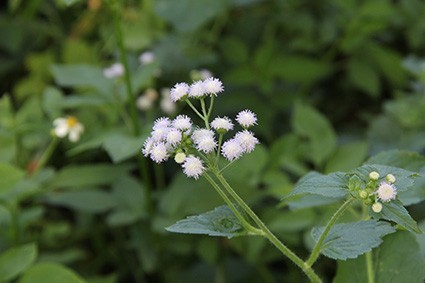Continuing our chronicle of weeds, we are reminded that a plant is called a ‘weed’ because, for the most part, it is a plant that annoys the agriculturists and gardeners, but, at the same time, it often has a value that is botanical, ecological, and also ethno-botanical.
Such is the case of Chromolaena odorata (synonym: Eupatorium odoratum) which belongs to the Daisy family, known scientifically as the Asteraceae. Differing from the Imperata cylindrica, of which we wrote in our last weeds text, today’s “weed” did not originate in Asia but was introduced from Central and South America. If one judges this “foreigner” by its vernacular names, it seems to have had trouble in adapting.
The Lao and the Thai call it “Nga phalang”, meaning “French grass”, but the French and the Vietnamese call it “Grass of Laos” (even though it’s not a grass at all). Actually, it was the French who introduced it in Southeast Asia in the 1920’s as ground cover. The English call it “Siam weed”, while the mountain dwellers of Vietnam say “Tlap yuan”, “Vietnamese grass”. But the Lahu of northern Thailand call it “Communist weed’, because they think that its appearance in their region was concurrent with the arrival of communism in China.
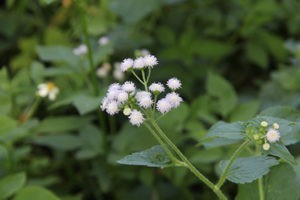
The adverse character of this plant is equally known in a number of languages. The Cambodians call it “invader of fields”, but in the tropics of Africa, where it was introduced in the 1940’s, it has been given more eloquent names: “Sekou Toure” on the Ivory Coast, “Bokassa” in Ghana, and “Mighbe” (“that which kills everything”) in the Cameroon. It must be said that in all the tropical countries where it has been introduced, at first it was considered as a “major pest”, partly because it reproduces so rapidly, and partly because it invades areas both cultivated and wild.
If you have travelled in Asia you have surely noticed it growing in undulating waves, in neglected fields, on the banks of rivers, at the sides of roads, and on fallow land. It is a shrub that can grow to three metres in shaded areas. Its three-veined leaves are in the shape of a heart, tapered at the tip, and its flowers grow in clusters of white, pink, or purple.
After having deplored the harmful effects of this invasive plant, farmers, researchers, agriculturalists, and decision-makers have learned how to maximise its beneficial effects and minimise those which are harmful.
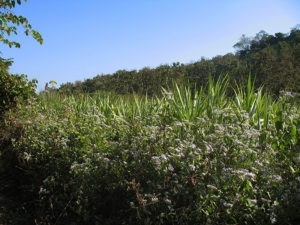
French Weed growing on the edge of a field of Sugar Cane in northern Laos
In Laos, after large areas of forest are cut down and burned to clear land, which the farmers cultivate for one or two years, these areas, stripped bare and abandoned, are frequently taken over by the “French Weed”. But, Madame Svengsuksa tells us, the appearance of this plant on the fallow land indicates that “fertility is assured for another cultivation cycle”. Therefore, “Nga phalang” has not only the advantage of serving to diagnose the condition of the land, but it also works as a fertiliser, contrary to its main rival “Nga kha” (Imperata cylindrica) which depletes the soil. Another point of interest concerning the “French Weed”, is that in areas of land that have been neglected, it provides an herbaceous ground cover, thus favouring the replanting of shrubs in the first years of fallow, and later allowing for the growth of a secondary forest. It is an excellent ground cover, which keeps the soil humid and fresh during the dry season. If the “French Weed” is well-managed, it could become an ecological useful tool to assist with controlling deforestation.
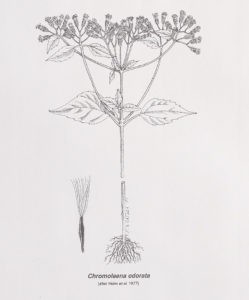
Botanical drawing of Chromolaena odorata.
When hearing the name given to the French West Indies’ Chromolaena odorata: “Cure All”, one could believe that the plant has medicinal uses, again without doubt little explored in Laos, since it has only recently been introduced. But here it has been recognised to have some antiseptic and coagulant uses; the raw leaves, either chopped or crushed, are applied to wounds, in particularly those caused by snakes. In Cambodia, “inhaling the aroma of the leaves serves to cure respiratory tract disorders.” The Hmong rub the crushed leaves on their skin to stop itching, and put them on cuts to promote healing. The Lisu of northern Thailand boil the leaves and use the liquid to bathe people who are feverish and suffering from malaria.
Moreover, “Nga phalang” has numerous small uses. Vidal tells us, in Cambodia, “the stem is used inside the shuttle like a bobbin to wind the thread for weaving.” In Laos, little girls use part of the stems to make bracelets and necklaces: they remove every second inch of the outer part of the stem from the bottom of the flower, which, left in place, then becomes the final pendant. As for the Cambodians, they have noticed that in the rice paddies, crabs which feed off their precious grain are killed if they eat the crushed leaves of this Asteraceae.
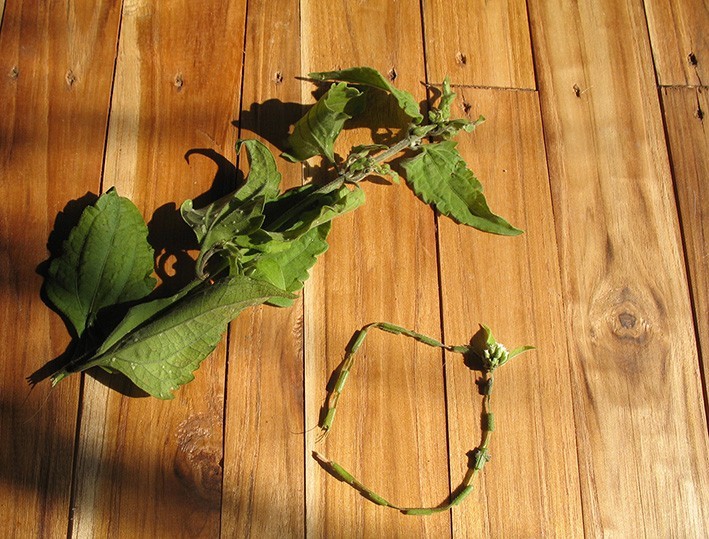
A bracelet made from Chromolaena odorata.
The history of this plant also gives us a good lesson in ecology; in effect, in its regions of origin, Chromolaena odorata is not invasive because more than 200 insects live off it and thus regulate its growth. But such insects are not found in territories recently occupied by the plant (tropical areas of Asia and Africa), hence it grows freely and uncontrolled in those areas.
In conclusion, whether this plant is either useful or a nuisance relates solely to the human context, a given instance and a specific territory. This is true of all ‘weeds’ after all.
By Dr Biba Vilayleck, PTK Resident Ethnobotanist
Translated from French by Gillian Marshall
Edits by Bryony Smart, PTK Botanist
Bibliography:
• Anderson Edward F. 1993, Plants and people of the golden triangle, Ethnobotany of the Hill Tribes of Northern Thailand,
Oregon, Dioscorides Press.
• Martin, Marie A. 1971, Introduction à l’ethnobotanique du Cambodge Paris, CNRS
• Svengsuksa, Bouakhaykhone, 2003, Reconstitution du couvert végétal et revalorisation des terrains après la culture sur
brûlis dans le district de Muang Fuang, province de Vientiane, RDP Lao. thèse de doctorat, MNHN Paris
• Vidal J. E. 1967, “Notes ethnobotaniques abrégées sur quelques plantes du Cambodge” dans Journal d’agriculture
tropicale et de botanique appliquée XIV 1-3 : 26-66. Paris
• Vidal J.E. et Lemoine J. 1970, “Contribution à l’ethnobotanique des Hmong du Laos” dans Journal d’agriculture tropicale
et de botanique appliquée XVII 1-4 : 1-59 Paris
• Zachariades C., Day M., Muniappan R., Reddy G. V. P., 2009, “Chromolaena odorata (L.) King and Robinson (Asteraceae)”
dans Biological Control of Tropical Weeds Using Arthropods publié par Rangaswamy Muniappan, Gadi V. P. Reddy,
Anantanarayanan Raman, Cambridge.



